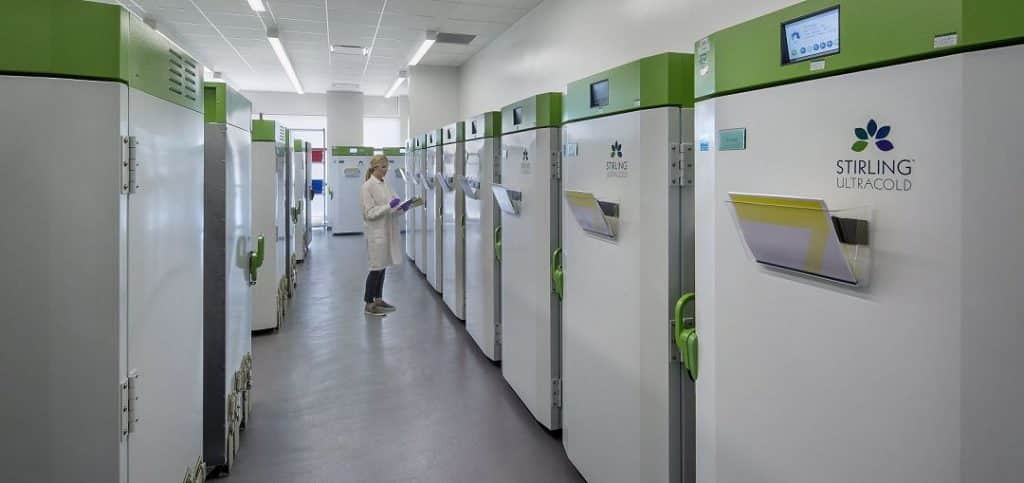Requirements for Freezing and Thawing Cells
Established cell lines are a valuable resource for research labs. However, even the best-kept cell lines in a continuous culture can be susceptible to genetic drift, senescence, and microbial contamination. Therefore, the cells must be frozen and preserved for long-term storage.
Below are some guidelines that are essential for freezing cells. As with all cell culture procedures, it is best to follow the instructions provided with your cell line for optimal results.
- Make sure that the cells are at least 90% viable and at a high concentration before freezing. Make sure to follow the optimal freezing instructions based on the cell line being used.
- Use a controlled rate cryo-freezer to freeze the cells slowly by reducing the temperature at 1 degree per minute.
- Always use the recommended freezing medium such as DMSO or glycerol. If freezing primary cells or cell lines for the first time, the use of a cell-specific, optimized freeze media such as BioLife CryoStor® family of freeze media is recommended.
- All solutions and equipment that come in contact with the cells should be sterile, including the cryovials used for storing frozen cells.
Thawing frozen cells can be a complicated procedure in which it is essential to be both quick and precise in order to guarantee that most of the cells will survive. For the best possible outcome, it is recommended that you closely abide by the instructions given with your cells and other components. For best results, follow these guidelines:
- Rapidly thaw the cells in a 37° C water bath until all visible ice has melted
- Before you incubate the cells, dilute them using a pre-warmed growth medium
- To enhance recovery, plate the cells that have been thawed at high density
- Work in a laminar flow hood and always use the correct aseptic technique
- Wear personal protective equipment such as a face mask or goggles (cryovials that are kept in a liquid phase could potentially explode when they are thawed)
- Some freezing media contain DMSO which aids the entry process of organic molecules into tissues. Make sure to use equipment to handle the chemicals that have DMSO.
- BioLife Cell Thawing Media is effective for larger volumes of placental/umbilical cord blood that is cryopreserved in bags of DMSO.

Materials Required for Thawing Cells
- Cryovial that holds frozen cells
- Sterile disposable centrifuge tubes
- Water bath at 37° C or an automated thawing device such as BioLife’s precision water-free ThawSTAR® CFT1.5 and CFT2 thawing systems.
- 70% ethanol
- Flasks, dishes, or plates that are tissue-culture treated
- Based on specified thawing procedure and temperature, liquid nitrogen (LN2) or ultra-low temperature (ULT) freezers can be used
Step-by-step Process for Thawing Frozen Cells
- Start by removing the cryovial that contains the frozen cells from liquid nitrogen storage or ultracold freezer.
- Place cell vial in a water bath at 37° C and gently swirl, until only a small amount of ice remains. Alternatively, use an automated cell thawing instrument such as the BioLife ThawSTAR® CFT1.5 or CFT2 by inserting the frozen cryogenic vial into the device. Retrieve it when the vial is raised at the end of the thaw cycle and proceed.
- Keep in mind that it is important to decrease exposure to room temperature when you remove frozen cells from storage. If cells are not going to be used immediately, place the cells on dry ice, or in a liquid nitrogen container. Cells in 1.8 mL and 2.0 mL cryovials can be transported from frozen storage to the thawing device inside the BioLife ThawSTAR® CFT Transporter while frozen on dry ice. Alternatively, cryovials containing cells can be transferred frozen at <-150℃ inside the BioT™ LN2 Transporter, which safely contains liquid nitrogen within an absorbent/baffle pad.
- Move the vial into a laminar flow hood.
- Wipe the exterior of the vial with 70% ethanol or isopropanol.
- Transfer the preferred amount of pre-warmed complete growth medium appropriate for your cell line into the thawed cells. Thawed cells frozen in cryovials are generally pipetted out of the small cryovial into a centrifuge tube containing a pre-warmed growth medium.
- Centrifuge the cell suspension at 200 x g for around 5-10 minutes at room temperature. The speed and duration of the centrifugation will change based on the cell types.
- Once the centrifugation is complete, check the clarity of the supernatant as well as the visibility of a complete pellet.
- Without disturbing the pellet, gradually pour the supernatant.
- Remove the supernatant with a pipette and leave a small amount of medium to ensure the cell pellet is not disrupted.
- Carefully tap the tube to resuspend the cell pellet.
- Move them into their appropriate cell culture vessel as well as the cell culture environment suggested.
- Now the cells are ready to be used in downstream applications.